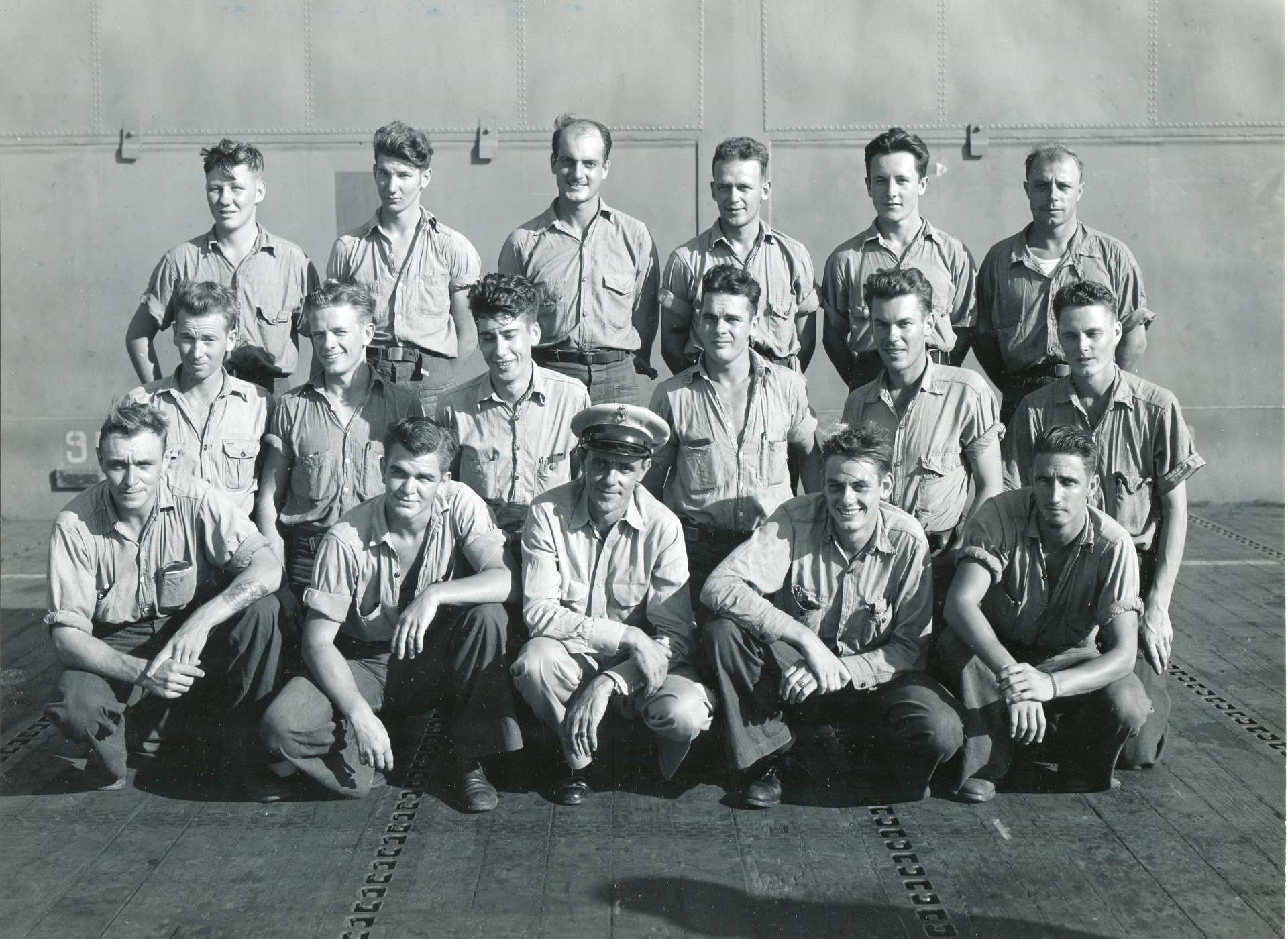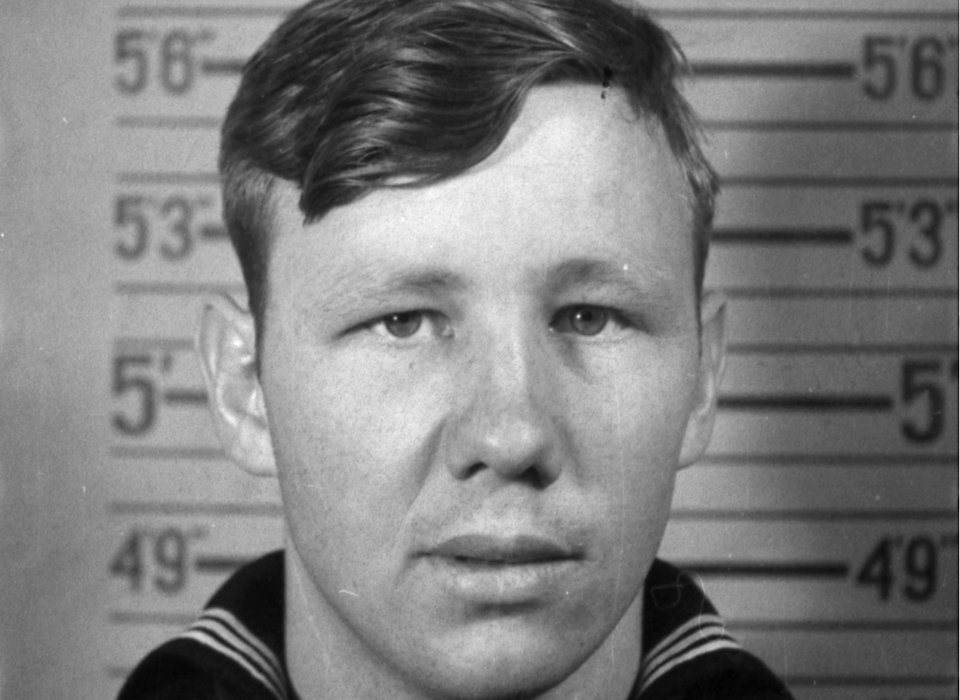Sunnyside, Georgia, native Jack Glass enlisted in the Navy on June 11, 1941, went through recruit training in Norfolk, Virginia. He knew from the moment he entered service that he wanted to fly.
Jack was accepted into Aviation Radioman School and sent to Naval Air Station Alameda, California, where he completed his training in June 1942, acquiring the rate of Aviation Radioman 3rd Class. Upon completion of his courses, Jack was assigned to the veteran aircraft carrier USS Enterprise (CV-6), which was stationed in Pearl Harbor following her decisive role in the Battle of Midway. Jack reported aboard his new ship on June 20 and was assigned to Fighting Squadron 6 (VF-6) as a radio technician. Less than a month later, Jack and Enterprise sailed from Pearl Harbor, bound for the tropical waters of the South Pacific off the shores of Guadalcanal.
As the freshest aviation radioman in the squadron, a great deal of Jack’s daily work, when not maintaining the radios in the fighters, consisted of flight deck duty. He worked helping to manually push the aircraft across Enterprise’s Douglas-fir flight deck in preparation for either launching or recovering her aircraft. It was hard, physical work, made more difficult by the sweltering heat and humidity of the South Pacific. On August 24, 1942, Jack was performing his duties on the flight deck when he acquired his baptism by fire.
Three US aircraft carriers were operating off of Guadalcanal in late August: Enterprise, Saratoga (CV-3), and Wasp (CV-8). Together, these three ships were the punching power of Admiral Frank Jack Fletcher’s task force, assigned to keep Imperial Japanese Navy forces from retaking the Marine-held island of Guadalcanal. On August 21, US Naval intelligence alerted the task force that a large Japanese force was, "although still apparently in Empire waters will definitely go south, if not already under way in that direction.” Naval intelligence was correct in predicting the Japanese fleet’s movements. For the next three days, Enterprise sent aircraft searching for the enemy. Finally, on August 24, Navy searchers picked up their prey, and American strikers headed towards the target, the Japanese aircraft carrier Ryujo. Shortly after the escort carrier was attacked, Enterprise scouts sighted two Japanese fleet carriers and radioed their location. Officers aboard Enterprise knew that a Japanese attack was inbound and made every preparation for the defense of their ship.

The gunners of Bombing Squadron Ten, with Jack Glass at top left.
The Big E launched her fighters which soon intercepted the inbound Japanese force. Enterprise fighters claimed 29 enemy kills in the aerial battle, but the losses sustained did not deter the enemy from finding and attacking the carrier. “At 1712, as the first of the surviving 30 Val dive bombers nosed over at 20,000 feet, a puff of smoke attracted the attention of 1st Sergeant Joseph R. Schinka (USMC).
“Commanding the Big E's #4 20mm anti-aircraft battery, Schinka opened fire. Though the enemy planes were still beyond the reach of the 20mm batteries, the gun's tracers guided the fire of other guns. In moments, a thundering barrage of 20mm, 1.1" and 5" fire filled the sky over Enterprise's flight deck, as North Carolina (BB-55), Portland (CA-33), Atlanta (CL-51) and the destroyers all came to her defense.” Jack was on the flight deck as the first Japanese dive bombers screamed down on his ship. “When they started making their bomb runs, I took cover . . . as best I could. There wasn’t much cover to take, but I got inside the island structure.” The first bombs missed the enormous aircraft carrier as she weaved through the waters with the surprising agility normally associated with smaller vessels.
However, despite her maneuvers and the valiant efforts of her gunners, Enterprise was struck just forward of her after elevator with a Japanese bomb that penetrated her flight deck and exploded deep in the bowels of the ship. Thirty-five of her crew were killed in the blast. Half a minute later, another bomb exploded on the carrier’s flight deck, a mere 15 feet from the location of the first explosion. This particular explosion was devastating. The blast wiped out the 38 men of the ship’s after starboard five-inch gun gallery, silencing the vital defensive battery and leaving Enterprise’s defensive firepower suddenly lacking. Regardless of her rather grievous wounds, the ship and her crew plowed forward, desperately attempting to escape the continuing aerial onslaught. The Big E was struck by one more bomb, up forward, that was fortunately a dud. Still, the projectile killed and wounded more of the ship’s crew.
When the fusillade of enemy aircraft had ended, Enterprise was still afloat. She was hurt. She was on fire, taking on water, and listing. Yet she maintained her position in the formation of ships and continued to operate, a testament to her valiant crew. Her precious flight deck had lived to fight another day and would continue to support the occupation of Guadalcanal. Eastern Solomons ended as an American victory, both strategically and tactically. Although Enterprise had been severely damaged, the Japanese assault had been driven off with the loss of the escort carrier Ryujo as well as many irreplaceable aircrews.
Jack Glass picked himself up off of the deck following the Japanese assault and helped to tend to his carrier’s wounds. After the ship had been temporarily repaired at sea by her crew, he wandered down to the area of the second bomb hit on the starboard five-inch gun gallery and saw what was left of some his shipmates. “That’s when I really growed up a little bit. I walked back and . . . looked at that terrible scene back there where these guys were all burned up. It was just a flash fire and they were just burned instantaneously. That’ll make a believer out of you if anything will.” Jack and Enterprise retired to Pearl Harbor for more permanent repairs, only to put to sea again, bound for the same place.
Jack continued to serve aboard The Big E, being transferred to Bombing Squadron Ten (VB-10), serving as a rear seat gunner in SBD Dauntless dive bombers. He saw action at Santa Cruz, the Naval Battle of Guadalcanal and Rennell before being sent back home with his squadron in early 1943. He would ship out aboard Enterprise one more time with VB-10 in 1944, seeing more combat in the Marshall Islands, Truk twice, Hollandia, the Marianas campaign, and the Battle of the Philippine Sea. He was discharged from the Navy in 1947 and went on to serve in the Air Force.
Seth Paridon
Seth Paridon was a staff historian at The National WWII Museum from 2005 to 2020. He began his career conducting oral histories and research for HBO’s miniseries The Pacific and holds the distinction of being the first historian hired by the Museum’s Research Department. In the 12 years he was Manager of Research Services, Seth and his team increased the oral history collection from 25 to nearly 5,000 oral histories.
Cite this article:
MLA Citation:
APA Citation:
Chicago Style Citation:









